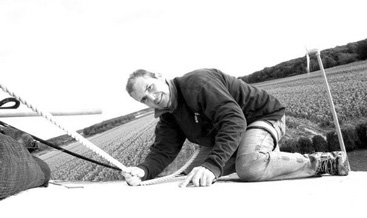Preface
As a homeowner with an interest in saving money with less conventional means, I am proud to play a role in the early adoption of renewable energy, and to share my experiences with others.
I planned on installing my first wind turbine on my property after the challenging experiences of building my home, which I call the Long Island Green Dome. It is a large geodesic dome located in Calverton, New York, and it required unique prep work. This involved erecting numerous 20- × 10-foot canopy tents and securing them in the ground with posts. Well, the ground posts didn’t hold well to the wind. When we returned one day, we found two tents missing. They took flight and tore apart. One imbedded itself on the dome frame, and the other was in pieces, threatening to go over the angry neighbor’s property.

Kevin Shea’s unique home in Calverton, New York, which he dubbed the Long Island Green Dome. One of the largest residential wood domes in the United States, it is powered by solar panels and a small wind turbine. Kevin Shea.
After that, we tied the canopy to heavy railroad ties. But some of the workers were afraid to go on the top of the frame during windy days for fear of blowing off. Debris from the site was flying over to the neighbors’ properties, making for more angry neighbors. Recently applied but not secured sheathing was constantly blown off the frame. Installing storm tarps on the structure required many hands and ropes, and I’ll never forget the day I was lifted off the ground while holding the edge of a tarp that rapidly filled with the wind. I remember when I first had the doors on, the wind came with such force that it blew one of the heavy, 4 × 8 metal and glass doors out, breaking the control arm right off. It was that year that I began to plan to grab that energy for my own.

On windy and sunny days, Kevin’s home produces an average of 8 kWh (kilowatt-hours). Since he gets paid 9 to 11 cents per kWh from his utility, he makes about $5.76 every eight hours. Kevin Shea.
I didn’t have a lot of money, and didn’t want to spend a lot of money. So, I spent time looking for something that was powerful enough, yet easy enough for a layman like me. It was the Skystream 3.7 by Southwest Windpower. I liked the idea that it had the inverter in the machine, that it looked sleek, didn’t have guy wires that would take up space in my yard, and could be a bit hidden from the angry neighbors. I applied for my permit, and found out there was no code except an old rule stating that any structure must not exceed 35 feet. I said, “No problem,” because the tower is only 33 feet.
The town official said, “Oh, no. You have to measure from the average grade of your property to the top of the blade as it is facing up.” That was disappointing. I knew the six-foot blades would throw it over the limit. Skystream offered that size because it met many local code requirements and could still produce energy (although as we’ll soon explain, higher towers are almost always much better for energy production, and are ideally in the 100-to 200-foot range).
Building the dome home was challenging, in part because of the property’s high winds. It was this blustery experience that first gave Kevin the idea to explore small wind power—although it’s also true that gusty days can be misleading at some sites. Kevin Shea.
So, initially, the only option was to apply for a variance, which meant opening up the decision of building the turbine with my angry neighbors. Although that’s a process we now recommend for a number of reasons, at the time, I decided instead on installing it exactly to the letter of the code. So, I dug the foundation deeper than necessary, bringing it lower than the average grade. When the town came to inspect it, the inspector would see that my tower was installed in a small “crater” garden, no taller than 35 feet from the average grade of my property. I didn’t know exactly what performance loss I would receive from this drop, but I was still ready to call victory.

The geodesic dome takes shape. Kevin did much of the work himself, although he recruited friends and hired some assistance. A lot of folks do the same for small wind projects. Kevin Shea.

Kevin originally called his house “Shea Stadium,” after the New York Mets’ arena. But after the pro baseball team built Citi Field, Kevin renamed his home the Long Island Green Dome. Kevin Shea.
People drop by and tell me that I am doing a good thing. That makes me feel great. And my power authority gives me a check (I combined wind and solar to exceed my needs) as per our net-metering agreement (more on this later). I am as close to being my own power plant as one can be on Long Island.
People frequently ask me a question that I didn’t readily have a quick answer to … until now: “Hey, Kevin, it’s windy here in ________ (fill in the blank). So why can’t we install some ‘windmill’ right on __________ (fill in the blank) to get some free electricity?”
That persistent question, and knowing the limited knowledge most people have of wind power, led me to propose this book on local, small-scale wind power. Fortunately, the answer is that we can, and should! And here is how!
Kevin Shea

